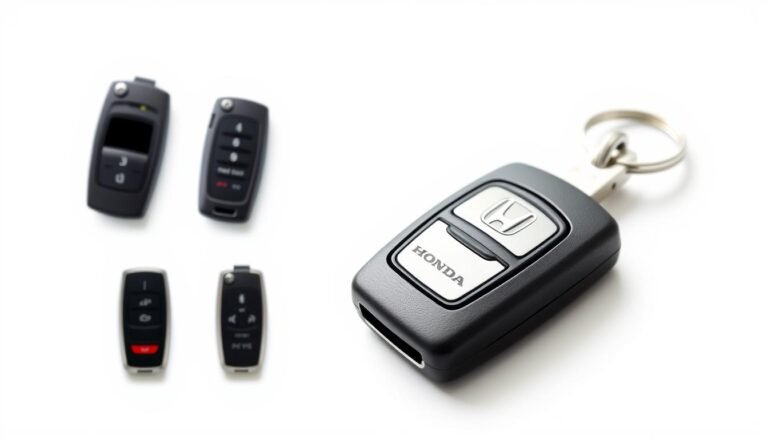VTM-4 Light Honda Pilot in Issues Explained
What is the VTM-4 light on a Honda Pilot? It shows there might be a problem with your vehicle’s all-wheel drive system. It’s very important that you deal with this issue quickly.
This article will explain the VTM-4 light in your Honda Pilot. We will cover reasons it turns on and how to fix it to ensure you’re driving safely.
In this guide, you will learn about common causes that may activate the VTM-4 light. These include sensor problems, low levels of differential fluid, and issues with the wiring harness.
We will talk about what to do if the light is flashing and options for when it stays on. You will also find out how to troubleshoot the VTM-4 light on your Honda for a better driving experience.
By the end of this, you should know what the VTM-4 light means and how to fix related problems.
This knowledge will help you take good care of your Honda Pilot. Now, let’s get into the details!
What is The VTM-4 System in Honda Pilot?
The Honda Pilot’s Variable Torque Management (VTM-4) system is a cutting-edge, electronically-controlled all-wheel-drive system.
It helps the car move better, especially on bad roads, rain, or snow. The system smartly shares power between the front and back wheels depending on how you drive.
This VTM-4 system makes the Honda Pilot handle better on slippery roads. It is more adaptable and responsive than regular all-wheel-drive systems.
Because of this, you get better control over your car when driving on tough roads. For those who drive in tricky conditions often, the VTM-4 system is a key feature of the Honda Pilot.
What Does The VTM-4 Light Mean on A Honda Pilot?
The honda vtm-4 light indicator is a key part of your Honda Pilot, especially for the all-wheel-drive system.
It serves as an alert when there’s a problem that needs quick attention. Normally, the VTM-4 light turns on then off again quickly as you start the engine.
But if it stays on or lights up while you’re driving, there’s likely a fault in the VTM-4 system. Knowing what the vtm-4 warning light means is vital for a smooth ride.
When the VTM-4 light is on, it means your system needs a check-up soon because there might be issues.
If you ignore this light, your car’s all-wheel-drive function could get worse, affecting your safety and the car’s performance.
Common Causes For VTM-4 Light Activation
When the VTM-4 light on your Honda Pilot turns on, it signals a problem. Knowing the vtm-4 light activation causes is key. Here are some common reasons for the light to come on.
Sensor Malfunctions
Bad temperature or pressure sensors in the rear differential can give wrong readings. This mistake can turn on the VTM-4 light.
Checking these sensors regularly helps avoid false alarms and keeps your car running well.
Low Differential Fluid Levels
If there’s not enough fluid in the differential, the light will warn you. This often happens because of leaks or not taking care of your car properly.
Making sure your fluid levels are good helps with troubleshooting vtm-4 light honda problems.
Wiring Harness Damage
If the wiring harness is damaged, the VTM-4 system may not work right. Things like rodents can cause damage.
It’s important to check the wiring for any issues to keep everything connected well.
| Cause | Description | Prevention/Tips |
|---|---|---|
| Sensor Malfunctions | Faulty temperature or pressure sensors leading to false alerts | Regular sensor checks can minimize errors |
| Low Differential Fluid Levels | Triggers light due to insufficient fluid, often from leaks | Perform periodic fluid inspections and top-offs |
| Wiring Harness Damage | Damaged wiring affecting sensor readings | Inspect wiring for damage, especially in prone areas |
Why Is The VTM-4 Light On My Honda Pilot Illuminated?
Seeing the VTM-4 light on your Honda Pilot means there might be a problem, big or small. Figuring out why the VTM-4 light is on can help fix issues before they get worse.
One common issue is low fluid in the differential, affecting the VTM-4 system’s operation.
Faulty sensors are another reason, especially in Hondas made from 2003 to 2008. For newer models, the problem could be with the engine or emissions system, making quick checks important.
It’s important to pay attention to what your car is telling you. Keeping an eye on the VTM-4 light helps your car work better and last longer.

VTM-4 Light Blinking Honda Pilot: What Should You Do?
When you see the VTM-4 light blinking in your Honda Pilot, act fast. It means there’s a big problem that needs quick fixing.
Steps To Take Immediately
Here’s what to do if the VTM-4 light starts blinking:
- Safely pull over to the side of the road.
- Shift the transmission into Park.
- Let the engine idle and observe if the light stops flashing.
- If the light keeps blinking after a few minutes, turn off the engine.
- Contact a towing service for help.
A blinking light warns of a serious problem that could damage your car. Acting quickly keeps you safe and your Honda Pilot in good shape.
Can I Drive My Honda Pilot with The VTM-4 Light On?
When the VTM-4 light turns on in your Honda Pilot, it signals a problem. This doesn’t mean you’re in immediate danger.
But, it shows something is wrong with the all-wheel-drive system. Now, your Pilot will work like it’s only front-wheel drive.
Knowing what the VTM-4 light means is important. You might keep driving for a bit, but the car won’t handle the same. This is especially true in bad weather or on uneven roads.
If you see the VTM-4 light, get your car checked out soon. Ignoring it might cause more issues or hurt the drivetrain. Quick action can keep your car running well and safely.

How To Turn Off The VTM-4 Light Honda Pilot?
The VTM-4 light on your Honda Pilot might mean there’s a problem that needs fixing. To turn it off, check the VTM-4 fluid and replace any bad sensors. Doing these steps the right way can make the light go out.
Check Fluid Levels
Start by checking the VTM-4 fluid. Honda says to change it every 7,500 miles. See if the fluid in the differential is low.
If it is, add more until it’s full. Use the kind of fluid Honda recommends. This keeps the VTM-4 system working well.
Inspect and Replace Sensors
Now, look at the VTM-4 sensors. Check the sensor wires for damage or wear. If you find bad sensors, they need to be replaced.
This job is something many people can do at home. Fixing these issues can help your Honda Pilot run smoothly.
Troubleshooting VTM-4 Light Honda Pilot Issues
When your Honda Pilot’s VTM-4 light comes on, start by checking the system’s fluid levels. Make sure the differential fluid is at the recommended level.
Low fluid can make the VTM-4 light turn on. If the fluids are fine, check the sensor outputs. Faulty sensors often cause the VTM-4 light to go on.
Then, look at the wiring harness for damage. Search for frayed wires or connections that are loose, as these can affect sensors.
Using a diagnostic tool helps a lot with this process. These tools read error codes from your car’s engine control unit.
This gives you details on what might be wrong. Following these steps makes fixing the issue easier, getting your car back in great shape.

How To Reset VTM-4 Light Honda Pilot?
Resetting the VTM-4 light in your Honda Pilot is a must after you fix the issues that caused it. You’ll need an OBD-II scanner for the reset process.
Start by plugging the scanner into the diagnostic port of your car. With the scanner connected, turn the key to the “On” position without cranking the engine.
The scanner will show fault codes. These codes tell you what problems turned the light on. Make sure you’ve made all the needed repairs before you try a reset.
To reset the VTM-4 light, go through the scanner menu to erase the fault codes. This step turns the light off. Then, unplug the scanner and turn the ignition off.
Turn your Honda Pilot on again to check if the VTM-4 light has stopped showing on the dash.
Here are the steps for a sure reset:
- Connect the OBD-II scanner to the diagnostic port
- Turn the ignition to the “On” position
- Retrieve and review fault codes
- Make sure all repairs are done
- Erase the fault codes with the scanner
- Unplug the scanner and turn the ignition off
- Start the car again
By following these steps on how to reset VTM-4 light Honda Pilot, your vehicle will run better. This ensures it stays reliable and performs well.
Repair Costs Associated with VTM-4 Issues
Fixing vtm-4 problems can have a wide cost range, depending on what’s wrong. Minor fixes like fluid replacement might cost less than $30.
This usually means adding or switching out the differential fluid, a simple job. However, bigger troubles can make the cost jump a lot.
For example, if there’s something wrong with the engine control unit or the rear differential, it could get pricey.
These repairs might cost anywhere from a few hundred to over $3,700. Knowing exactly what the issue is helps figure out how much you might have to spend.
Getting a handle on these repair costs lets you plan your vehicle’s care and your budget better.
Here’s a table that outlines common vtm-4 troubles and what you might expect to pay for repairs:
| Issue | Estimated Repair Cost |
|---|---|
| Fluid Replacement | Below $30 |
| Sensor Replacement | $200 – $500 |
| Wiring Repair | $150 – $300 |
| Rear Differential Replacement | $1,000 – $3,000 |
| Engine Control Unit Replacement | $1,500 – $3,700 |

Preventative Measures For VTM-4 Light Problems
Maintaining your Honda Pilot ahead of time helps avoid VTM-4 light issues. Routine checks and maintenance tips can lower the chance of these problems. These strategies act as preventative steps for VTM-4 issues.
Regular Maintenance Tips
- Schedule regular oil changes to keep the engine running smoothly.
- Inspect fluid levels, particularly differential fluid, to ensure they are within acceptable ranges.
- Conduct sensor cleanings periodically to avoid malfunctions.
- Check the wiring harness for signs of wear, especially if you park in areas prone to rodent activity.
- Ensure tires are properly inflated to reduce stress on the drivetrain.
- Monitor driving conditions and adapt maintenance schedules for harsh climates.
Following these Honda Pilot maintenance tips boosts your vehicle’s performance and life. Putting preventative steps first ensures a safe, reliable drive for many years.
Conclusion
The VTM-4 light on Honda Pilots alerts you when your all-wheel-drive system needs a check-up. It’s really important for Honda Pilot owners to know about this.
Addressing VTM-4 light triggers can help keep your car in good shape. This guide aims to give you the knowledge to maintain your car well.
Dealing with VTM-4 issues can also help you save money by avoiding bigger problems later.
It’s key to regularly check your car, quickly solve problems, and act fast when lights come on. Doing these things helps keep you safe and extends your Honda Pilot’s life.
In summary, paying attention to what your car tells you, especially the VTM-4 light, is crucial.
Knowing its role allows you to take good care of your car. This way, you can ensure your Honda Pilot performs well and your drives are smooth.
FAQs
Q: What does the VTM-4 light indicate in my Honda Pilot?
A: The VTM-4 light warns of issues in the Variable Torque Management system. This system is key for the all-wheel-drive.
Q: Why is the VTM-4 light on but not blinking?
A: A steady VTM-4 light means the all-wheel-drive is off. This could change how the car drives. It’s vital to get it checked soon.
Q: How do I troubleshoot the VTM-4 light in my Honda Pilot?
A: First, check the differential fluid and sensor function. Look for damage in the wiring too. A diagnostic tool can pinpoint errors.
Q: What should I do if the VTM-4 light is blinking?
A: If it blinks, pull over and switch to Park. Let the engine run to see if the light stops. If not, turn off the engine and maybe call for a tow.
Q: How can I reset my VTM-4 light?
A: Solve the issue first, then use an OBD-II scanner to reset. Ensure all repairs are done to stop the light from coming back.
Q: What are common causes for the VTM-4 light to turn on?
A: The light often means sensor trouble, low fluid, or wiring issues. Good maintenance can avoid these problems.
Q: Can I drive my Honda Pilot with the VTM-4 light on?
A: You can drive for a bit, but the all-wheel-drive won’t work. Getting it fixed quickly is important.
Q: What are the repair costs associated with VTM-4 light issues?
A: Costs vary. Small repairs may be cheap, but big problems could cost a lot. Some repairs might need over ,700.
Q: How often should I perform maintenance to prevent VTM-4 issues?
A: Keeping up with fluid changes every 7,500 miles and checks can keep the VTM-4 light off. Regular care is best.







